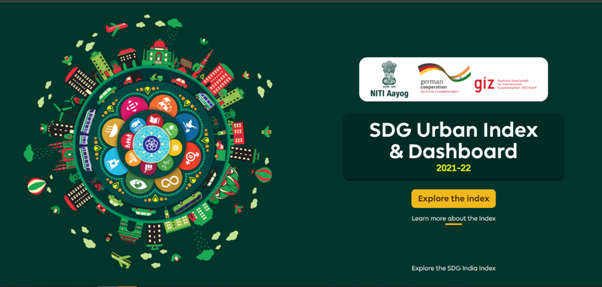SDG Urban Index and Dashboard
SDG Urban Index and Dashboard
In its journey towards localizing the Sustainable Development Goals (SDGs) and instituting robust SDG progress monitoring systems at the national, State/UT, and local levels, NITI Aayog has launched the SDG Urban Index & Dashboard during November 2021.
Scope of coverage
The SDG Urban Index and Dashboard ranks 56 urban areas on 77 SDG indicators across 46 targets of the SDG framework. The data on these indicators have been sourced from official data sources such as NFHS, NCRB, U-DISE, data portals of various ministries, and other government data sources.
Out of 56 urban units, 44 have population of above one million. The remaining 12 are capital cities with population of less than a million.
Indicators covered
 The 77 indicators are from across 15 SDGs. SDG 14 (life below water) has not been included as it is relevant for only coastal areas, and SDG 17 (partnerships for the goals) has been excluded as it is not relevant at the ULB level.
The 77 indicators are from across 15 SDGs. SDG 14 (life below water) has not been included as it is relevant for only coastal areas, and SDG 17 (partnerships for the goals) has been excluded as it is not relevant at the ULB level.
The indicators cover the sectors of poverty reduction, nutrition, health, education, women empowerment, water and sanitation, clean energy, economic growth, industry, infrastructure, reduced inequalities, urban development, climate action, forests, and governance.
The data on these indicators have been sources from official data sources such as NFHS, NCRB, U-DISE, data portals of ministries, and other government data sources.
For each SDG, the urban areas are ranked on a scale of 0-100. A score of 100 implies that the urban area has achieved the targets set for 2030; a score of 0 implies that it is the farthest from achieving the targets among the selected urban areas. Overall or composite urban area scores are then generated from the Goal-wise scores to measure aggregate performance of the urban area.
Urban areas have been classified as below based on their composite score:
- Aspirant: 0–49
- Performer: 50–64
- Front-Runner: 65–99
- Achiever: 100
Benefits
The index and dashboard will further strengthen SDG localization and institute robust SDG monitoring at the city level. It highlights the strengths and gaps of ULB-level data, monitoring, and reporting systems. Tools such as this index and dashboard will contribute to the creation of an ecosystem in which all stakeholders will be equipped to adopt and implement data-driven decision making. This transformative change is quite essential, given the increasing prominence of our cities and urban areas in charting the future of development in our country.
SDG Urban Index and Dashboard 2021–22
Top 10 Urban Areas
| Urban Area |
State/UT | Composite Score |
| Shimla | Himachal Pradesh | 75.50 |
| Coimbatore | Tamil Nadu | 73.29 |
| Chandigarh | Chandigarh | 72.36 |
| ThiruvanantHapuram | Kerala | 72.36 |
| Kochi | Kerala | 72.29 |
| Panaji | Goa | 71.86 |
| Pune | Maharashtra | 71.21 |
| Tiruchirapalli | Tamil Nadu | 70.00 |
| Ahmedabad | Gujarat | 69.79 |
| Nagpur | Maharashtra | 69.79 |
To view the complete list, click here.
Last Modified : 12/6/2022
This topic provides information about World breast...
Provides information about International Youth Day...
This topic provides information about World Food S...
Provides information about International Day of Cl...
